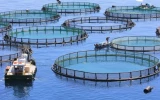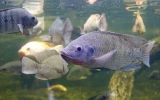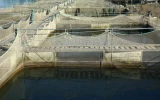Is Fish Farming Profitable? (Full Cost & Profit Breakdown)
Fish can convert 70% of their feed into body tissue, which makes them an efficient and profitable livestock option. With great dress-out qualities, they can convert about 60% of their body weight into marketable products. Given this fact, fish farming can be a profitable venture if managed efficiently and effectively.
The profitability of fish farming is generally high. A small fish farm may be able to sell 2,000 pounds of fish per month, generating about $168,000 in annual revenue with a profit margin of approximately 40%. The cost to set up and run a small farm is anywhere from $4,900 to $12,600.
In order to maximize your profits, focus on keeping costs low, especially feed costs, which make up 70% of the total variable costs of fish production in farms. Also, make sure to grow fish that have a ready market and a stable, predictable price. For example, tilapia is the second most farmed fish worldwide and is commercially farmed in over 85 countries.
Jump to investment costs table
Summary
- There is a growing demand for fish as a nutritious and sustainable food source, especially among health-conscious consumers.
- You may want to consider the popularity, the price, and the farming conditions of the fish you will grow for profit.
- Tilapia is a species worth exploring for potential profitability.
- Automated feeding systems and recirculating aquaculture systems are some of the innovative technologies you can employ in your fish farming operation to boost its profitability.

On this page:
Costs and Profit Breakdown Showing the Profitability of Fish Farming
The profitability of your fish farming business will heavily depend on your knowledge and ability to run the farm efficiently and effectively. The costs of a fish farm can vary depending on several factors, such as the size of the farm, the type of fish being raised, the equipment and technology used, and the location of the farm.
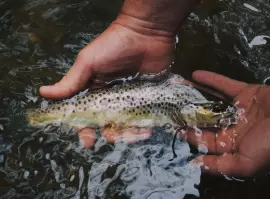
For a small fish farm, the total startup and running costs can start at $4,900. This includes the cost of a small pond or tank, a water recirculating or aeration system, filters, fish feed, nets, water testing kits, cleaning tools, an initial stock of fish, and electricity and water utilities.
Investment costs may be significant, but when you properly manage your fish farm and keep expenses in check, you'll have a profitable business in the long run.
Investment costs
| Investment Costs of Fish Farming | Small Fish Farm | Medium-Sized Fish Farm | Large Fish Farm |
|---|---|---|---|
| Ponds or tanks | $1,000 to $10,000 | $10,000 to $50,000 | $100,000 to $500,000 |
| Water recirculating or aeration system | $1,000 to $5,000 | $5,000 to $25,000 | $50,000 to $250,000 |
| Filters | $500 to $1,000 | $2,000 to $5,000 | $10,000 to $50,000 |
| Fish feed | $500 to $1,000 | $2,000 to $5,000 | $50,000 to $250,000 |
| Nets | $100 to $200 | $500 to $1,000 | $5,000 to $10,000 |
| Water testing kits | $100 to $200 | $500 to $1,000 | $10,000 to $50,000 |
| Cleaning tools | $100 to $200 | $500 to $1,000 | $5,000 to $10,000 |
| Initial stock of fish | $500 to $1,000 | $5,000 to $10,000 | $50,000 to $250,000 |
| Total investment cost | $2,400 to $7,600 | $25,000 to $92,000 | $280,000 up |
Infrastructure costs include ponds or tanks
When starting a fish farming business, you'll need to consider the costs of building the necessary infrastructure. For an outdoor pond, construction costs tend to range from $3,000 to $10,000, depending on the size and complexity of the pond. Indoor tanks, on the other hand, are generally less expensive, with prices typically falling between $1,000 and $3,000.
You'll also need a store for keeping supplies, such as feed and equipment; this can cost around $5,000 to $10,000.
Equipment and supplies include water systems
Once you've taken care of the infrastructure, you'll need to invest in equipment and supplies. This includes:
- A water recirculating or aeration system for maintaining oxygen levels in the water, which is vital for the survival and growth of your fish. The cost can vary depending on the type and size of the system.
- Filters for maintaining water quality, with prices dependent on the scale and complexity of your setup.
- Fish feed, which accounts for a significant portion (50%–70%) of your operational expenses. Therefore, managing feed costs effectively is crucial for your farm's profitability.
- Maintenance equipment, such as nets, water testing kits, and cleaning tools.
Initial stocking of the fish species for your farm
After setting up the infrastructure and gathering the necessary equipment, you'll need to acquire the initial stock of fish to start your farming operation. The cost of acquiring juvenile fish depends on the species and the quantity needed. Some common species for fish farming include catfish, tilapia, and trout, among others. Make sure to research the appropriate price range for your chosen species.
Operating Expenses to Keep Your Fish Farm Running
This section details the main operating expenses of fish farming, covering costs related to feed, labor, maintenance and repair, and utilities. If you carefully manage these operating expenses, you can maximize the profitability of your fish farming business while maintaining the health and quality of your fish.
| Ongoing Expenses of Fish Farming (annually) | Small Fish Farm | Medium-Sized Fish Farm | Large Fish Farm |
|---|---|---|---|
| Fish feed | $500 to $1,000 | $2,000 to $5,000 | $50,000 to $250,000 |
| Labor | $1,000 to $2,000 (assuming part-time or self-managed) | $10,000 to $20,000 | $175,000 to $350,000 |
| Maintenance and repair | $500 to $1,000 | $2,000 to $5,000 | $30,000 to $150,000 |
| Electricity and water utilities | $500 to $1,000 | $2,000 to $5,000 | $15,000 to $75,000 |
| Total operating cost | $2,500 to $5,000 | $16,000 to $35,000 | $270,000 up |
Fish feed accounts for the majority of the running costs
Feed is one of the most significant expenses in fish farming, accounting for 50–70% of operational costs for some farms. It's important to strike a balance between the cost per pound and the performance of the feed you choose. Consider factors like the nutritional requirements of your fish and the conversion ratio of feed to weight gain.
It may be tempting to choose cheaper feed options, but it's crucial to consider quality and performance for the long-term profitability of your fish farm. Some tips to optimize feed costs:
- Use high-quality feed that offers a better feed conversion ratio
- Monitor and adjust feeding practices to optimize feed consumption
- Utilize technology and data to track growth rates, feed consumption, and waste management practices
Labor cost for your fish farm
Appropriate staffing is vital for running an efficient fish farm. You'll need to hire personnel to manage feeding, monitor water quality, maintain equipment, and oversee daily operations. Depending on the size and complexity of your farm, your labor costs will vary. Keep in mind that investing in well-trained and skilled employees can contribute to the overall success and profitability of your fish farming business.
Maintenance and repair of fish farming equipment
Regular maintenance on equipment, like aerators, water pumps, and filtration systems, is crucial to ensure they function correctly and maintain optimal water quality for your fish. Setting aside a portion of your budget for routine maintenance and possible repairs will help safeguard your farm against unexpected expenses and minimize the risk of losses due to equipment failure.
Utilities include water and electricity
Utilities such as electricity and water are necessary expenses for your fish farm. Electricity powers aeration systems, water pumps, lighting, and other necessary equipment. Your water supply must be reliable and of suitable quality to ensure the health and growth of your fish. To minimize utility costs:
- Invest in energy-efficient equipment
- Utilize technology to monitor and optimize energy and water usage
- Consider renewable energy sources, such as solar panels, if feasible for your location and farm size
How to Generate Revenue from Farming Fish
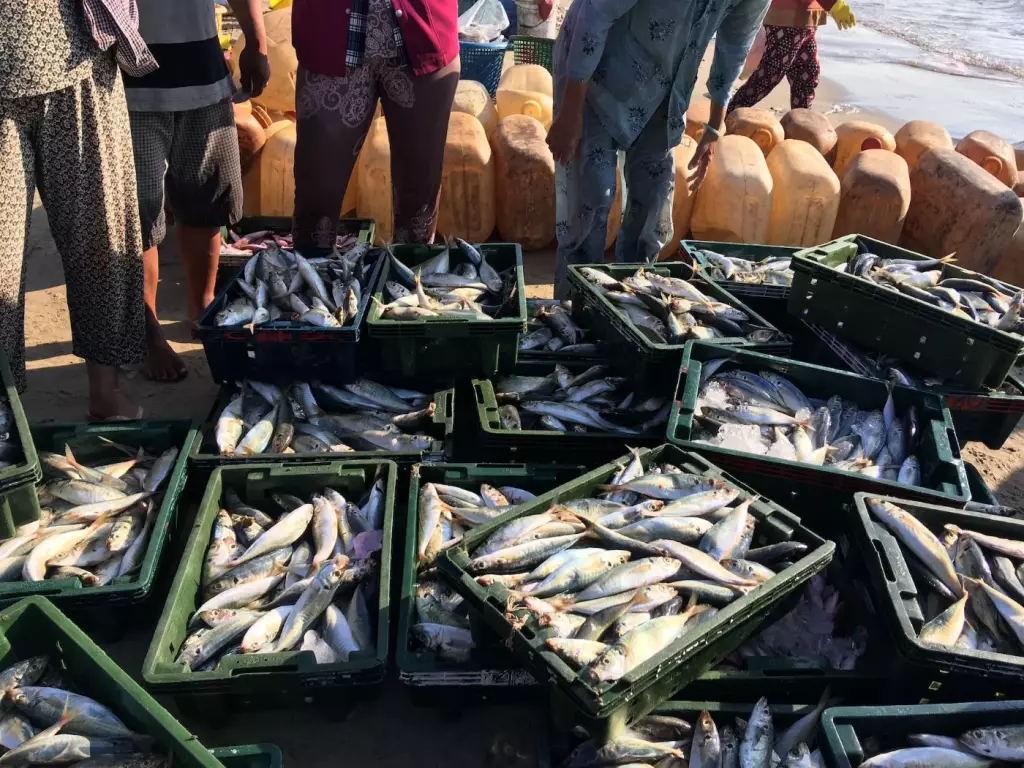
Market prices of the fish you farm
When you consider fish farming as a business, it's essential to understand the market prices for various fish species. As a fish farmer, you can expect an average price of about $7 per pound wholesale, depending on the species you're farming.
The profitability of your fish farming business will depend on reducing feed costs and finding a market for a fish species with stable, predictable prices and high demand.
Sales channels for your fish products
To maximize your revenue, it's important to establish multiple sales channels for your fish farming products. Some channels to consider include direct sales to local customers (such as restaurants, hotels, and supermarkets), as well as online sales through platforms like aquarium or pet fish websites if you are producing ornamental fish.
Additionally, working with wholesalers and distributors who can reach markets globally will help increase your fish farming business's potential revenue.
In your first year or two, you may be able to sell 2,000 pounds of fish per month, generating about $168,000 in annual revenue with a profit margin of approximately 40%. The revenue can significantly increase as your fish farming venture expands and you explore new markets.
Keep in mind that the global fish farming market is expected to grow at a compound annual growth rate of 5.8% from 2019 to 2027, reaching a market size of $378,005.5 million by 2027. This growth projection suggests that investing time and effort in your fish farming business now could lead to increased revenue in the future.
Breakeven to Profit from Fish Farming
To maximize the profitability of your fish farm, it's essential to understand the factors affecting profitability, compare profits to traditional fishing, and focus on the aspects of the business you can control.
Here's the breakeven point calculation for a small fish farm given the average market price of $7 per pound of fish:
Assuming a production cost of $5 per pound, the breakeven point for a small fish farm would be:
Breakeven point = Total costs / (Price per pound - Production cost per pound)
Breakeven point = $2,400 / ($7 - $5) = $2,400 / $2
Breakeven point = 1,200 pounds of fish
Therefore, the small fish farm would need to sell at least 1,200 pounds of fish at $7 per pound in order to break even and cover its costs.
Factors affecting the profitability of your fish farm

One of the most significant expenses that can directly impact your profits in fish farming is the cost of feed, which accounts for 50%–70% of total costs.
-
Feed efficiency: By optimizing the feed components and feeding schedule, you can reduce the cost of feed and increase profits. This will help your fish grow faster and healthier, resulting in higher yields.
-
Type of fish: Different fish species have different growth rates and market demands, which affect profitability. For example, tilapia farming can be profitable when done correctly due to its fast growth rate and popularity in the market.
-
Production methods: Choosing the right fish farming method, such as intensive, extensive, or aquaponics, can significantly impact the cost of production and overall profitability. Research has shown that aquaponically produced vegetables have good potential for profitability, while the fish portion can break even or incur a net loss.
-
Market prices: The prices at which you can sell your fish in the market play a crucial role in determining your profits. Premium prices in high-end markets will be necessary for the fish and vegetables produced in aquaponics to be profitable.
Fish farming profits versus traditional fishing
Comparing the profitability of fish farming to traditional fishing isn't a direct comparison, as the two methods have different operating costs, production scales, and environmental impacts. Broadly speaking, fish farming allows for better control over production, allowing for more predictable harvests than traditional fishing, which is subject to natural fluctuations in fish populations and environmental conditions.
However, it's important to note that both methods have their own set of challenges and opportunities. Ultimately, the success of your fish farming venture will depend on your ability to manage costs effectively, adapt to market demands, and continuously optimize your operation.
Boost the Profitability of Your Fish Farm
If you consider implementing innovative technologies and efficient management practices in your fish farming operation, you can boost your profitability and ensure the long-term success of your business.
Innovative technologies increase your fish farm profit
To increase profitability in your fish farming business, it is vital to embrace innovative technologies that can help reduce costs and increase productivity. One such technology is recirculating aquaculture systems (RAS). Implementing RAS can offer several benefits, such as:
- Improved control over water quality
- Reduced water usage
- Minimized environmental impact
- Increased biosecurity

Another innovation to consider is the use of automated feeding systems. These systems can:
- Ensure optimal feeding rates
- Lower labor costs
- Enhance feed conversion ratios
When you combine these technologies with other innovations, such as solar-powered aeration or water quality monitoring systems, you can increase profitability in your fish farming operation.
Efficient management practices to adopt in your fish farm
Adopting efficient management practices can also significantly impact the profitability of your fish farm. Some essential practices to incorporate include:
- Optimize stocking density: Ensure you provide an optimal environment for fish growth and avoid overcrowding. This can lead to improved fish health and growth rate, reducing the risk of diseases.
- Monitor water quality: Regularly monitor and maintain ideal water conditions for your fish species, as this can have a substantial impact on their overall performance and contribute to increased profits.
- Effective waste management: Implementing waste management strategies can help keep your farm clean, reduce odors, and decrease the risk of diseases, leading to higher profits.
- Diversify fish species: Cultivating multiple fish species can allow you to tap into various markets and audiences, leading to increased income.
- Effective marketing and distribution: Develop relationships with local and export markets, restaurants, and other potential buyers to ensure a steady demand for your products, ultimately increasing your profit margins.

